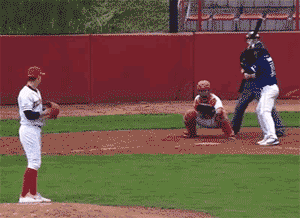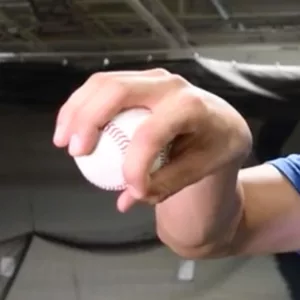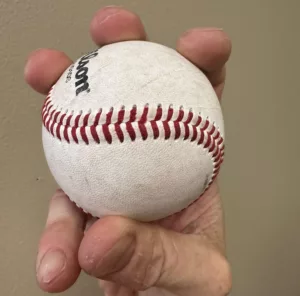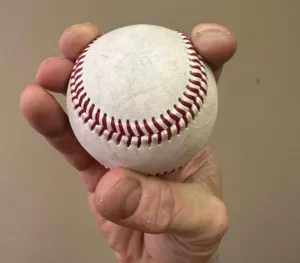Need to learn to change up grips? This is the guide!
 When it comes to thriving in the game of baseball, mastering the art of pitching is an absolute must for any pitcher who wishes to dominate the game. The change-up pitch is one of the most powerful weapons in a pitcher's arsenal of strategies and approaches. This deceptive and off-speed pitch has an extraordinary ability to throw batters off balance and keep them wondering. The important factor to successfully completing a change-up, though, is the pitcher's grip. A tight grip and precise control are essential.
When it comes to thriving in the game of baseball, mastering the art of pitching is an absolute must for any pitcher who wishes to dominate the game. The change-up pitch is one of the most powerful weapons in a pitcher's arsenal of strategies and approaches. This deceptive and off-speed pitch has an extraordinary ability to throw batters off balance and keep them wondering. The important factor to successfully completing a change-up, though, is the pitcher's grip. A tight grip and precise control are essential.
In this comprehensive tutorial, we will delve into the wide range of change-up grips designed exclusively for baseball pitchers. Each grip will be accompanied by a full breakdown, shining light on the complexities involved and providing pitchers with essential pointers on how to throw each grip efficiently. Whether you're a seasoned pitcher looking to improve your mechanics or a rising star hoping to develop a new pitch, this guide will be an invaluable resource. By going into the depths of each grip and revealing its secrets, you will be equipped with the information and skills required to improve your pitching proficiency and, ultimately, rise above the competition.
The Ultimate Guide to Change Up Grips
As a pitcher, the grip you use on your change-up can have a big impact on its movement, speed, and effectiveness. We'll look at different change-up grips, their benefits and drawbacks, and how to grasp the ball for the best outcomes.
The Circle Change Up Grip
 One of the most common change-up grips used by pitchers is the Circle Change-Up Grip. Follow these steps to execute this grip:
One of the most common change-up grips used by pitchers is the Circle Change-Up Grip. Follow these steps to execute this grip:
- Hold the baseball in a circle with your index and thumb, as if you were making a "OK" sign.
- Put the baseball deep in your hand, against your palm.
- Your remaining three fingers should be placed along the outside of the ball to provide support.
- This grip enables the pitcher to generate a tight spin and downward movement on the pitch. When used against right-handed batters, the Circle Change-Up
- Grip causes the ball to break away from them.

The Three-Finger Switch Change Up Grip
 Pitchers benefit from improved control and a different release point with the Three-Finger Change-Up Grip. To perfect this grip, follow these steps:
Pitchers benefit from improved control and a different release point with the Three-Finger Change-Up Grip. To perfect this grip, follow these steps:
- Use your index, middle, and ring fingers to grasp the baseball. Place your fingers across the seams to ensure a solid grip.
- Place the ball against your palm, deep in your hand.
- For stability, place your thumb beneath the ball.
Pitchers who wish to generate less movement while focusing on deception and speed reduction will benefit from the Three-Finger Change-Up Grip. It provides for a steady release point, making the pitch difficult to recognize by batters.
The Change Up Grip with Split Fingers
 The Split-Finger Change-Up Grip is an alternative to the standard fastball grip. To improve this grip, follow these steps:
The Split-Finger Change-Up Grip is an alternative to the standard fastball grip. To improve this grip, follow these steps:
- With your index and middle fingers split apart on the seams, hold the baseball.
- Along the outside of the ball, place your ring and pinky fingers close together.
- For stability, keep your thumb underneath the ball.
When compared to other change-up grips, the Split-Finger Change-Up Grip has a different action and release point. It has a sinking movement that makes it an effective pitch against aggressive batters. However, maintaining control and preventing the pitch from slipping out of your hand takes practice.
Checkout this Episode of the #TopVelocity Show
In this episode, we talk about Extreme Long Tossing problems and MLB pitcher David Aardsma goes over his changeup grip.
Change Up Grips: Questions and Answers
- What is the ideal change-up grip for a starter?
The Circle Change-Up Grip is frequently recommended for beginning pitchers. Its simplicity makes it easier to control and execute consistently. Begin with this grip and progress to different grips as you acquire confidence and expertise. - How can I make my change-up pitch move more?
Focus on grip pressure and wrist action to improve your change-up pitch movement. You may generate additional movement and effectively fool batters by exerting slightly more pressure and pronating your wrist upon release. - Are there any dangers involved with changing grips?
When done correctly, change-up grips carry little danger of injury. It is, nevertheless, critical to maintain appropriate mechanics and avoid overexertion. To reduce the danger of strain or injury, practice your change-up tosses on a regular basis and gradually raise the intensity. - Can I use the same grip on every change-up pitch?
While it is feasible to utilize the same grip for all change-up pitches, experimenting with different grips is encouraged to create a diversified repertoire. Having a variety of change-up grips in your repertoire allows you to keep batters guessing and improve your overall performance as a pitcher. - How can I improve my command and accuracy when pitching change-ups?
Consistent practice and focus are required to improve command and accuracy with change-up throws. Begin by throwing change-ups during bullpen sessions and work your way up to game conditions. Maintain a smooth and repeatable motion by paying attention to your grip, release point, and mechanics. - What distinguishes change-up grips from other off-speed pitches?
Change-up grips are designed to reduce pitch speed while preserving deception. Curveballs and sliders, for example, require distinct grip variations and mechanics to generate movement and break. Change-up grips prioritize reducing speed while retaining the same arm movement as a fastball, making them very useful against aggressive batters.
Unleash Your Potential with TopVelocity Pro Pitch Analytics
 Ready to unlock the full potential of your pitching performance? Introducing TopVelocity Pro Pitch Analytics, the most advanced online pitch analysis available! Whether you're recovering from an injury, experiencing arm pain, or looking to take your velocity to new heights, our cutting-edge analytics tools are here to provide you with the direction and insights you need to break through plateaus.
Ready to unlock the full potential of your pitching performance? Introducing TopVelocity Pro Pitch Analytics, the most advanced online pitch analysis available! Whether you're recovering from an injury, experiencing arm pain, or looking to take your velocity to new heights, our cutting-edge analytics tools are here to provide you with the direction and insights you need to break through plateaus.
With Pro Pitch Analytics, you can expect individual pitch analysis, opportunities for improvement, and even a major league pitch grade assessment. Don't wait any longer—take the first step towards optimizing your pitching skills and achieving your goals. Get your analysis now and let Pro Pitch Analytics be your ace in the hole!
Please note that for a proper analysis, TopVelocity Pro Pitch Analytics requires at least three pitches of each pitch type. These pitches should closely represent your average or peak velocity and location. While CSV files are preferred, we also accept screenshots or pitch/bullpen reports.
For those seeking a deeper dive into their arsenal, our Video Analysis option is available. By providing high-speed video footage captured from behind the pitcher's hand at a second base position, our analytics team can conduct a thorough breakdown of your pitch grips and ball release. This additional information allows us to provide you with more detailed recommendations and a roadmap to success.
Data and Video Analysis services are available for individuals, teams, and entire facilities. Don't miss out on this opportunity to gain valuable insights and propel your pitching performance to the next level. Take control of your game—enroll in TopVelocity Pro Pitch Analytics today!


